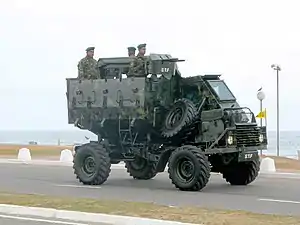| Buffel | |
|---|---|
.jpg.webp) Decommissioned Buffel in Port Elizabeth. | |
| Type | MPAV |
| Place of origin | South Africa |
| Production history | |
| Designer | Council for Scientific and Industrial Research |
| Specifications | |
| Mass | 6.14 t |
| Length | 5.1 m (16.73 ft) |
| Width | 2.05 m (6.73 ft) |
| Height | 2.95 m (9.68 ft) |
| Crew | 1+10 |
Main armament | Optional M1919A4 / FN MAG 7.62 mm MG |
| Suspension | 4×4 wheeled |
Operational range | 1000 km (620 mi) |
| Maximum speed | Road 96 km/h (60 mph) Off-road 30 km/h (19 mph) |
The Buffel (English: Buffalo) is an infantry mobility vehicle used by the South African Defence Force during the South African Border War. The Buffel was also used as an armoured fighting vehicle and proved itself in this role. It replaced the older Bedford RL-based Hippo APC and itself was replaced by the Mamba from 1995 in South Africa,[1] but remains in use elsewhere, notably Sri Lanka.
Production history
The Buffel was the first truly effective landmine-protected armored personnel carrier to enter service anywhere.[2] The South African Army began deploying it in the operational area from 1978. The Buffel was an improvement over the Bosvark which offered little protection to the driver. In 1974, 54 Mercedes-Benz Unimog 416-162 chassis had been hastily converted into Bosvarks by 61 Base Workshops in Pretoria. The Bosvark offered limited landmine protection to the crew, but compensated for this with good off-road mobility.[1][3] It is estimated that around 2,400 Buffels were delivered before production stopped. Sri Lanka purchased Buffels in the 1980s, and in the early 1990s the vehicle was exported to Uganda.[1]
The Buffel (Afrikaans for Buffalo) was not a wholly South African built vehicle, but made use of the chassis, engine and some other components of the Mercedes-Benz U416-162 Unimog,[1] which were fitted with a domestically designed armoured driver's cab and separate armoured troop compartment. The cab was situated on the left with the engine compartment on the right. Later models replaced the original Mercedes-Benz OM352 engine[1] with copies built under license by Atlantis Diesel Engines factory near Cape Town.
Land mine protection was provided by the V-shaped hull underneath these compartments, which quite effectively deflected the blast. The troop compartment contained two plastic tanks in the vee beneath the floor: a 200-litre fuel tank and a 100-litre water tank. The water tank provided drinking water to the occupants by means of a tap at the rear of the vehicle.
In order to help dissipate the energy from hitting a mine, the large tyres were sometimes filled with water, adding about 500 kg per wheel to the vehicle weight.[4]
Variants
SAA variants
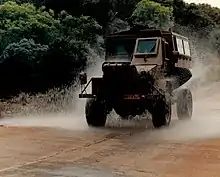
- Buffel - original
- Buffel Mk 1 - Improved engine and bush guard (bumper)
- Buffel Mk 1B - Disc brakes replaced drum brakes[1]
- Log Buffel - Logistic/Cargo version, a standard Buffel with the seat assembly removed from the troop compartment
- Buffel Mk IIA - Essentially a rebuild of earlier Mk 1s with an enclosed troop compartment, a rear exit door and large bulletproof windows on the sides and rear. Referred to as Moffel.[1]
- Buffel Mk IIB - Cargo carrier. The SA Army ordered 57 of these in the early 1980s. Payload capacity stated as 2.637 tons.[1]
SAAF variants

- Bulldog - based on SAMIL 20 truck with the driver's cab on the right. The Bulldog was utilized by the SAAF for patrolling airfields. A variant called the Ystervark was produced and used in the anti-aircraft role.[1]
- Rhino - A further development of the Bulldog but with the driver seated inside a fully enclosed troop compartment. 20 were produced for the SAAF.[1]
Sri Lankan variants
- Unicorn - Sri Lanka Army produced version of the Buffel original.
- Unibuffel - Sri Lanka Army produced version of the Mk I and Mk II with Tata and Leyland engine and an enclosed troop compartment.
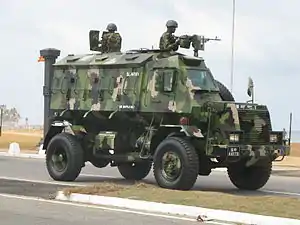
Operators
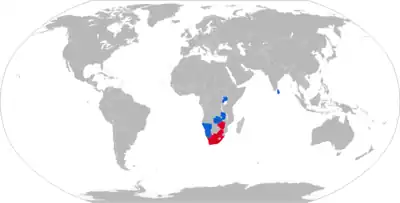
Current operators
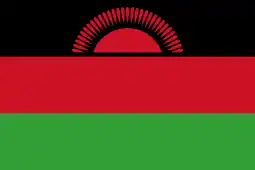 Malawi: 1; Rhino variant.[5]
Malawi: 1; Rhino variant.[5] Sri Lanka: 47;[5] other variants produced as the Unicorn and Unibuffel.[6]
Sri Lanka: 47;[5] other variants produced as the Unicorn and Unibuffel.[6]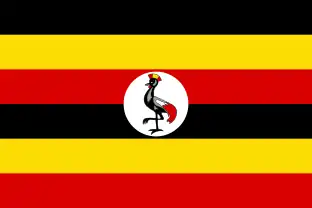 Uganda: 55; 20[7][8] in service with the army and 35[9] in service with the national police.
Uganda: 55; 20[7][8] in service with the army and 35[9] in service with the national police. United Nations Mission in South Sudan: 3[10]
United Nations Mission in South Sudan: 3[10] Zambia: 1; Rhino variant.[5]
Zambia: 1; Rhino variant.[5] United Nations Multidimensional Integrated Stabilization Mission in Mali; nine Unibuffels were deployed to Mail under urgent operational requirements for peacekeeping operations in Mali.[11]
United Nations Multidimensional Integrated Stabilization Mission in Mali; nine Unibuffels were deployed to Mail under urgent operational requirements for peacekeeping operations in Mali.[11]
Former operators
 South Africa: Formerly around 2,400 in service; all retired and replaced by the Mamba.[6]
South Africa: Formerly around 2,400 in service; all retired and replaced by the Mamba.[6] United Nations Transition Assistance Group: 1[5]
United Nations Transition Assistance Group: 1[5]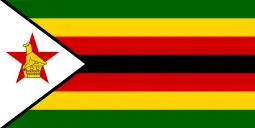 Zimbabwe: Possibly inherited from Rhodesia.[12]
Zimbabwe: Possibly inherited from Rhodesia.[12]
Combat history
See also
Vehicles of comparable role, performance, and era
References
- 1 2 3 4 5 6 7 8 9 10 Surviving The Ride. 30 Degrees South. 19 September 2014. ISBN 978-1-928211-17-4. Retrieved 2015-07-24.
- ↑ Heydenrychsays, Willem (2019-10-31). "Buffel APC/MPV". Tank Encyclopedia. Retrieved 2021-02-03.
- ↑ Engelbrecht, Leon (2010-01-21), Fact file: Mamba APC/MRAP, DefenceWeb, retrieved 2013-07-09
- ↑ Heydenrychsays, Willem (2019-10-31). "Buffel APC/MPV". Tank Encyclopedia. Retrieved 2021-02-03.
- 1 2 3 4 "Trade Registers". Armstrade.sipri.org. Retrieved 2014-11-20.
- 1 2 Camp, Steve; Helmoed-Römer, Heitman (November 2014). Surviving the Ride: A pictorial history of South African Manufactured Mine-Protected vehicles. Pinetown: 30 Degrees South. pp. 31, 239. ISBN 978-1928211-17-4.
- ↑ "Ugandan People's Defence Force". defenceweb.co.za. 2015-01-30. Archived from the original on 2016-12-30. Retrieved 2015-06-28.
{{cite web}}: CS1 maint: bot: original URL status unknown (link) - ↑ "Scramble for the Congo - Anatomy of an Ugly War" (PDF). ICG Africa. 2000-12-20. Archived from the original (PDF) on 2013-10-29. Retrieved 2013-06-18.
- ↑ "Uganda: SA Sends in Police Armour as Museveni Faces Civil Unrest". South Scan. Washington, D.C. 22 April 2005. Archived from the original on December 30, 2016. Retrieved 30 December 2016.
- ↑ "United Nations Register of Conventional Arms: Report of the Secretary-General" (PDF). New York: United Nations. 15 July 2014. Archived from the original (PDF) on 5 August 2017. Retrieved 4 October 2016.
- ↑ "'Mali needs us' | The Sunday Times Sri Lanka".
- ↑ Pretty, Ronald (November 1986). Jane's Weapon Systems, 1986–87 (1986 ed.). Macdonald and Jane's Publishers Ltd. p. 1021. ISBN 978-0710608321.
External sources/Bibliography
- Video footage - Buffel
- Video - The South African Buffel & How an MRAP Works
- Buffel Mine-protected APC/ video footage
- Jane's Land Warfare Platforms 2014/2015: Logistics, Support & Unmanned ISBN 0710631308 Jane’s Land Warfare Platforms: Logistics, Support & Unmanned
- Jane's Land Warfare Platforms 2015-2016: Logistics, Support & Unmanned ISBN 0710631723
- Jane's Military Vehicles & Logistics 2004-2005 ISBN 0710626312 Jane’s Land Warfare Platforms: Logistics, Support & Unmanned
